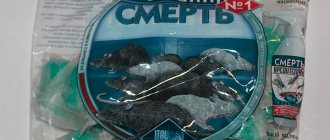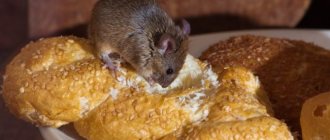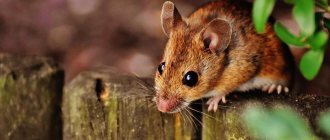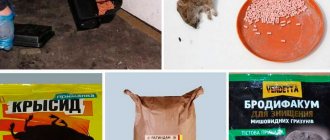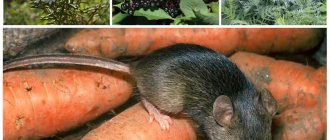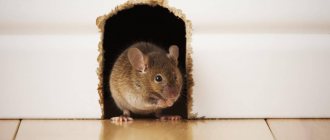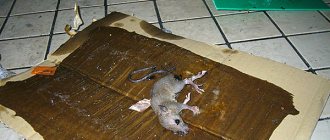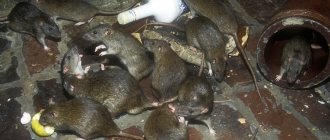When gray rodents appear at home, owners use different methods of control. Ready-made and homemade traps are a good way to catch dangerous “neighbors.” It is important not only to correctly place the device for catching rodents, but also to know which bait for mice in a mousetrap is the best.
Useful tips will be useful to all owners who are faced with the penetration of gray pests into a private house or apartment. The most popular baits, making a homemade trap for rodents, what should not be put in a mousetrap - these are just a small part of the issues covered in the article.
Causes of mice
With the onset of cold weather, the risk of “uninvited guests” appearing in a person’s home increases. In summer, there is enough food in fields and garbage dumps, and mice are less likely to get into apartments and houses.
In late autumn, the harvest is harvested, the remains are eaten, frozen food waste is not to the taste of rodents. What to do? Go in search of food and warm shelter. For this reason, mice and rats enter cellars, apartments in high-rise buildings, granaries, storerooms, and private houses. From basements, rodents reach not only the first floors, but often climb higher along the floors. Rats in a chicken coop also bring a lot of trouble.
A simple test will help you understand how high the risk of encountering mice in your home is. For each “Yes” answer, score 1 point, for each “No” – 0 points.
Questions:
- Do dirty dishes often end up in the sink?
- Do owners always wipe down the dining table immediately after eating?
- How long does a trash can with rotting waste last?
- Are there any spilled cereals, flour, pasta, or seeds on the shelves of the kitchen cabinet?
- How cluttered is the pantry: a lot of garbage, old things or not?
- Is there a garbage dump or food waste bins near your house?
- Is it easy to find freely available water (pipes are leaking, there are often wet rags on the floor)?
- Are crumbs on the table or kitchen floor a common occurrence?
- Are containers with bulk products tightly closed?
- Does the housewife buy flour and cereals “in reserve”?
- Are there holes in the baseboards, near sewer pipes, in the floor, or in the walls of the cellar?
- Do the owners keep poultry?
Got 3 or more positive responses? We will have to urgently reconsider our attitude towards order and pay more attention to protecting the home from rodents
How to get rid of weevils in an apartment and preserve food supplies from harmful bugs? We have the answer!
Where is the best place to put a mousetrap?
Some useful tips:
- Since mice prefer to live in human homes at night, it is better to install mousetraps in the evening, and you can check them in the morning.
- It is better to install a trap next to the hole, although this is not critical.
- To be more effective, you will have to install several mousetraps in different places. Basically, mice are attracted to the kitchen, since it is where edible odors come from.
Harm
Mice bring a lot of trouble to people:
- they chew through bags and bags of cereals and flour;
- leave excrement among loose products;
- carry pathogens of dangerous diseases on their paws and fur;
- damage wires;
- scare household members;
- attack poultry, steal eggs;
- rustling at night in the pantry, under the stove, disturbing sleep;
- excrement scattered on the floor dries and releases substances that provoke allergic reactions.
Flour products
Bread, cakes, various buns and loaves are another delicacy that mice love. Stale bread is perfect , since the teeth of these rodents grow throughout their short lives and constantly need to be ground down against something hard.
The smell of bread also plays an important role, since it is smells that mice react to. To be on the safe side, you can also soak the bread in any liquid poison or hide a piece of poison in the bread crumb. This guarantees that if suddenly the mousetrap mechanism does not work, the mouse will die at least from poisoning. And since these animals are not as smart as rats, they can fall into such a trap several times.
In addition to bread, you can also use buckwheat, rice, pearl barley and other cereals.
You can also take either a crust from the bread for the mousetrap, or make a ball, like from plasticine
Mouse bait: useful tips
Various types of trapping devices are effective in catching rodents. The important point is to lure the cunning creature. Not every product is suitable for attracting mice and rats. There are several myths regarding the most delicious bait for rodents. What is the truth and where is the fallacy? Let's figure it out.
How to attract rodents
A strong, pleasant smell is a prerequisite for catching rodents using ready-made and homemade traps. The product must be natural: rats and mice cannot tolerate chemicals. For example, cheap smoked sausage always loses to aromatic sunflower oil or toasted seeds.
An important point is the quality of the bait for rodents. Old lard, rotten fish, cheap smoked sausage, rotten cereals are bad options for catching mice and rats. Cunning creatures are always more willing to eat natural, fresh foods than chemicals.
What is recommended to put in a mousetrap?
TOP – 7 products that attract rodents:
- Salted or smoked lard. The popularity of the bait has been tested by many generations of owners. An important condition: use aromatic, fresh lard: rancid, old lard is unlikely to attract picky rodents.
- Vegetable oil. The ideal option is an unrefined product with a clearly distinguishable, pleasant smell. Moisten the crust of bread with sunflower oil or dip a cotton swab into the oily liquid. Many rodents react positively to the aromatic product pressed from sesame seeds, but sunflower oil is more attractive.
- Grain, baked goods. Many owners believe that fresh baked goods mixed with whole grains or bran are a great attractor for gray pests. A simple trick increases the effectiveness: moisten a piece of bread with unrefined sunflower seed oil. Treatment of buckwheat, millet, rice, and rat poison enhances the effect on rodents.
- Cold smoked fish. Another popular product, like a magnet, attracts rats and mice. High quality bait is a must. Rodents quickly feel that the owner spared them fresh fish, put in old, rotten food, and avoid the trap.
- Sausages. Not a bad option if there are no other products from the top of the rating. Unfortunately, most sausages contain flavorings, flavor enhancers, chemicals, and preservatives. Smart rodents will rarely covet a product that doesn't contain many natural ingredients. If you choose sausage, it should be homemade, with a minimum amount of chemicals.
- Smoked cheese. This option will help you catch a rodent: regular cheese has a less characteristic smell, dries out quickly, and is less attractive to mice. Smoked sausage cheese is exactly what you need.
- Raw minced meat with onions. This option is suitable for attracting rats. If the owners do not know who is rustling under the stove or in the pantry, but from the damage caused they guess that the rodent is large, a mixture of ground meat, onions and rat poison will help. The main thing: add a little poison so as not to interrupt the aroma of natural bait. Also use finely chopped onion in moderation: for about 10 parts of minced meat – 2 parts of a product with a bright aroma.
Not recommended baits
Knowing little tricks will help owners catch “uninvited guests” more effectively. There are foods to which rodents react less strongly.
Mice are less likely to touch the following baits:
- dried cheese;
- a piece of apple;
- chocolate;
- cheap, low-quality sausage;
- old lard;
- dried out baked goods.
Selection of traps
In the fight against rodents, special devices are used. Let's look at how to choose a mousetrap or rat trap.
The traps have a similar mechanism of action, but differ in size. The body length of rats reaches 30 cm, which is 5-6 times the size of mice. Traps are made of wood, plastic, and metal.
The following types of products are supplied to stores:
- Mechanical (trap, snare). They are a simple design that pinches and suffocates the rodent, preventing it from getting out. The bait is placed in a mousetrap. The bait should be attractive to mice. The mechanism is triggered when the animal reaches the food.
- Electrical. The pest killer comes in the form of a plastic container with a built-in mechanism that delivers an electric shock. The bait is placed inside, the rodent climbs in for food and dies from electric shock.
- Live traps. They are made in the form of cages and boxes. After catching the pest, it is released far from home.
- Glue traps are boards with a sticky coating, once on which a mouse cannot escape.
The devices kill or leave animals alive. The device is cleaned after each use.
Homemade mousetraps are made from plastic bottles, glass jars, and buckets. Place bait (seeds, grains, flour, lard, etc.) into the container and approach the neck. The mouse ends up in a container and can't get out.
Catching a large rodent is difficult, since luring a rat into a rat trap is quite difficult. The cunning design is made from pipe scraps, and a fragrant bait is placed at the end. The tunnel is built on the principle of a swing. When an animal walks over it, the device tilts. The beast falls into a deep basin. To be safe, pour water into the container.
How to catch gray pests
To catch rodents, manufacturers offer several types of devices:
- mechanical mousetrap;
- live trap for catching mice;
- containers, cages;
- electric mousetrap.
How the simplest and most accessible version of the trap works:
- The mechanical device consists of a clamp, a trigger and a holder. All metal elements are mounted on a wooden plank;
- Before starting the “operation”, put on gloves. Mice and rats smell well, understand that a person has been here, and do not touch cooked food;
- To charge the mousetrap, take bait from TOP - 7 and place it on the trigger. Check whether a piece of lard or bread is securely fastened, otherwise the cunning rodent will carefully take out the treat and run away without affecting the trap mechanism;
- the next step is to cock the clamp. Carefully place the holder and insert the element into the trigger. It is important to ensure that the holder slides off easily at the slightest touch;
- It is not always possible to charge the device quickly and correctly the first time; several training sessions will be required. It doesn't hurt to be careful: the pressure hits your fingers painfully;
- After charging, the device is ready for use.
How does a mechanical trap work:
- a mouse or rat smells the bait, touches the treat, grabs the trigger;
- then the actions follow a chain: the holder slides, the clamp releases, the mousetrap slams shut, the mechanism firmly presses the rodent;
- If a large rat “pecks” at the bait, it can drag the device with it.
Advice! A lighter, wooden structure is suitable for catching mice; a product with a metal base will help to catch a rat.
Where to put the mousetrap
Helpful Tips:
- the optimal time for installing devices is evening: mice and rats do not like daylight, they quietly move around the apartment or house at night;
- It is important to inspect baseboards, corners, cluttered areas, the perimeter of the pantry and cellar. Be sure to place a mousetrap next to the mink;
- To catch rodents, place several devices along the walls, under the oven, behind appliances, between the wall and the cabinet, near any openings in the floor that are not yet covered. If there is space between the pipes and the wall, place a trap there too.
How to make a device with your own hands
It’s easy to make a mouse trap with your own hands from items that you always have at home. Minimum costs, maximum efficiency.
What do you need:
- bucket with water;
- a sheet of paper, a notebook cover or a desk calendar;
- bait with a bright aroma.
Learn how to remove wood lice from your bathroom and prevent the insects from breeding.
Procedure:
- fill the bucket with water (about a third);
- place on the floor at the edge of the table;
- make a structure like a house out of paper;
- place the pyramid closer to the edge of the table: half of the house is on the tabletop, the second hangs over a bucket of liquid;
- Place bait on the edge hanging over the container with water, level the structure so that lard or a piece of bread does not outweigh the second area;
- The principle of operation of the trap is simple: the mouse smells the bait, approaches it, the light house tips over, and the rodent falls into the water.
Traps with food
There are ready-made traps with bait inside for sale. This is a great option for those who don't want to bother with cooking it themselves. The poison only affects pests. It is absolutely safe, so accidentally eaten bait will not harm your pets.
The trap mechanism is designed in such a way that it is designed only for rodents. The bait can be changed and is suitable for reusable use. At the same time, the smell does not become less intense. The trap comes with a spare bait. Therefore, if the mouse died in a trap, having eaten all the food, you can put in a new one. Its properties remain active for a whole year.
Traps with bait do not require you to prepare the bait yourself, since it is already present there in advance
The following companies have proven themselves well:
- Swissinno;
- SuperCat.
The trap comes with detailed instructions for use. It contains information about the rules for installing and charging the trap.
Preventive measures
Mice and rats often live in basements and attics, enter homes from landfills, or move from field to home during seasonal migration. Why do some owners constantly complain about the penetration of rodents, while others practically never encounter gray pests?
To solve the question, you will have to remember the test from the first section. If there were too many “Yes” answers, you need to correct the situation. Preventing the appearance of rats and mice in your home will be successful if there are as few positive answers to the test questions as possible. There is often no escape from being close to a garbage dump, but regularly removing food waste, maintaining order in the apartment, getting rid of holes and cracks in the floor, walls, baseboards, and not filling your home with bags of cereals and flour is a feasible task.
Suitable bait for mice in a mousetrap, knowledge of the behavioral characteristics and taste preferences of cunning rodents, installation of several traps are the main measures for catching gray pests. A simple test will help you understand whether there is a risk of rats and mice settling in your home. It’s easier to keep rodents out of your apartment than to hunt dangerous “neighbors.”
Below is a video about how to make a mousetrap from improvised materials and what to use as bait:
Find and neutralize
Expert opinion
Evgeniy Koshalev
I dig in the garden at the dacha until the last rays of sunshine every day. No specialty, just an amateur with experience.
Catching a mouse is possible, although difficult. In this article I want to share with you the most effective baits that you can use to catch a mouse.
In order to catch a mouse correctly and quickly, you need to know where it most often lives. Mice are predominantly nocturnal pests; they do not have much intelligence or order in their pack. They shit where they sleep and live.
Here is a list of places that deserve maximum attention:
- along vertical surfaces;
- near the trash can;
- bottom cabinet drawers;
- under the furniture.
Basic Rules
According to reviews, any of the listed products can be bait for mice in a mousetrap. But for the bait to be effective, you need to follow some rules:
- It is necessary to check the freshness of products.
- You should not put the same treats. For all traps you need to use different food.
- The position of the devices must be changed daily.
- If one feeding is ineffective, you should use another.
Such recommendations will allow you to quickly eliminate these gray pests from your home, which are dangerous to people.
Plants
The mouse is an object of hunting not only for predatory animals and birds. Nepenthes spathulata is a plant that eats mice. This plant predator belongs to the insectivorous family and grows on the islands of Sumatra and Java. It is a stem on which there are many pitcher flowers. They emit a sweet floral scent that attracts insects and small mammals. An approaching mouse is absorbed by the flower thanks to its slippery surface, due to which the rodent is no longer able to get back out.
The length of this unique plant can reach 5 m. Like owls, the plant predator swallows insects, rodents and other small animals whole. The bones, teeth and fur of the victim are digested thanks to special digestive enzymes.
Salo
When asked what mice love most, experts answer lard. Rodents can easily recognize high-calorie foods, which they can fill up quickly and for a long time. Lard is considered the most effective assistant in catching mice. To enhance its attractiveness, the treat is lightly fried with a match to make the smell more captivating. It is necessary to use fresh lard with an attractive aroma; the smell of old and stale lard repels them.
To save money, you can put the skin with the remaining lard in the rat trap. Such bait will not deteriorate for a long time and will retain an appetizing smell for the mouse.
Method number 2: flower pot
Required:
- a clay or plastic pot with a hole in the bottom; if the second option is used, then it is weighted with a weight;
- thread;
- match or toothpick;
- clip;
- bait;
- piece of plywood.
Making a trap:
- The pot is turned upside down on a sheet of plywood.
- The thread is pulled through the hole. A match is tied to the outside of the pot, and the bait is attached to the inside with a paper clip. The bait should hang almost at the very bottom.
- The upper edge of the pot is supported by a match with a thread tied to it.
- The structure is installed in a rodent habitat.
When the rodent reaches for the bait, the match will act as a trigger and the pot will cover the pest.
What about cheese?
The idea that rats and mice love cheese most of all has spread thanks to cartoons. You can see a rodent chasing a cheese treat in Tom and Jerry, Chip and Dale, and Ratatouille. Perhaps a mouse with cheese looks more aesthetically pleasing than one with lard.
Be that as it may, real rodents don't like cheese. It is a myth. Of course, if the mouse is hungry, it may bite into a piece of cheese. But other baits work much more effectively.
If you decide to catch a mouse with cheese, use a smoked product. It attracts rodents much better.
What smell do rats not like according to folk recipes?
Quicklime can be lethal to rats
Traditional recipes are less effective compared to chemical occupational poisons, but they are less dangerous for children and pets.
The most popular homemade mixtures include the following:
- A mixture of gypsum and flour in equal proportions, place a bowl of water next to it. The mixture will harden in the stomach and the entire digestive system will turn to stone.
- Quicklime with sugar (in equal proportions) in the stomach will turn into acid and burn through all organs.
- A mixture of 150 grams of soda, 100 grams of flour and 100 grams of sugar promotes increased gas formation, which is fatal for rats.
Important! You can also drive away rats by scattering herbs with a strong and unpleasant odor near the holes or by planting them in your summer cottage. What smell repels rats? Wormwood, chamomile, mint, garlic cause fear among mice and rat groups
Herbs will smell stronger if you change the bouquets regularly.
Dog or cat food
It is known that rural and urban rodents are very different in their preferences. They choose the food that they were used to eating in childhood and which has the highest calorie content. Often this product is cat or dog food. Lard and sausage in the apartment are securely hidden in the refrigerator, but the pet’s bowl is in the public domain. Plus, pet food smells strong. Walking past it is a real challenge for a mouse.
Recipe from the Vredstop website: 1 oatmeal cookies, 3 corn sticks, 1 teaspoon of halva, 10 peeled seeds. Crush the mixture in a mortar and use it as bait for rats and mice.
Capture methods
There are at least four options for catching pests using improvised means available in almost every home:
- glass jar;
- flower pot;
- plastic bottle;
- a bucket with a capacity of five or more liters.
There are other methods of catching mice at home that require more serious preparation and a trip to the nearest hardware store:
- live traps are a kind of mouse trap, with the only difference being that the mouse will not be harmed; you can make it yourself or purchase a ready-made device;
- special glue for rodents;
- ready-made glue traps;
- rat poison - the disadvantage of this method is the inability to detect a corpse that emits an unpleasant odor;
- a cat or cat - the method is not always reliable: there are pets that themselves try to hide as soon as they see a small mouse.
By the way, the use of adhesive substrates is not suitable for humanists: trying to free itself from a trap, the animal makes heartbreaking sounds that only a person with an impenetrable psyche can withstand.
Vegetable oils
Vegetable oils are used as bait for mice in a mousetrap. It is advisable to choose unrefined sunflower. You cannot use the product in its pure form, but you can soak a piece of bread with it. You can use cotton wool soaked in oil.
Rodents react strongly to sesame products used as a salad dressing. The smell of this oil is aromatic and attractive. This product is considered the most popular among mice from vegetable oils.
Components and properties of adhesive compositions against mice and rats
Mouse repellent glue is an effective tool that can be used to get rid of rodents or at least greatly reduce their numbers. To understand how effective it is, you need to understand what is included in the composition.
Main components:
- Cycloisan.
- Polyisobutylene or polybutylene.
The combination of these substances is a viscous mixture that remains sticky for a long time. The principle of operation can be explained in a visual sequence:
- The owner of the premises calculates the places where the animals run more often than elsewhere, looking for “mouse trails”.
- The adhesive composition is applied to the selected areas in an even layer.
- While running along the usual path, the animal ends up on a sticky area and begins to struggle, thereby getting bogged down even more.
To more effectively attract the attention of rodents, you can scatter pieces of food over the mouse-catching glue. It is necessary to apply the adhesive mass on flat surfaces made of monolithic materials
Do not leave a homemade device in a room with high humidity or a lot of debris. An unpleasant moment is removing the body from a dried surface.
Advantages and benefits
Rat glue has a number of strengths and weaknesses. Advantages of the method:
- The adhesive composition does not emit toxic fumes during use.
- Easy to use. You don't need any additional skills to use mouse repellent.
- There is no unpleasant smell.
- The adhesive mass does not dry out for a long time, while firmly holding any object that falls on it.
- Availability, low cost.
- Weather conditions do not affect the effectiveness of the purchased product.
- Long shelf life.
The adhesive composition easily holds large rodents, which allows it to be used effectively against rats.
Disadvantages of glue and glue traps
Rodent repellent glue has a number of weaknesses. These include:
Low efficiency with a large number of mice. Such situations can be overcome by combining poisons with traps over a large area
It is important to block all passages and “poison” the main paths. Pets may accidentally step on the sticky area. It is difficult to remove carcasses from the adhesive layer.
This method of killing rodents is considered inhumane, since the animal will die for a long time and painfully.
How to Remove Mouse Glue from Pet Fur
Ubiquitous pets can get into a mouse trap. The fur and paws of pets instantly become stained with glue, and there is only one way to quickly remove it: trim the animal.
It is more convenient to carry out this procedure with an assistant. One person holds the kitten, and the second trims dirty areas of fur from the cat. Only sharp and small scissors should be used.
If a cat gets caught in a mouse trap with its paws, you won't be able to use scissors. In this case, you need to use oil. Wet the animal's skin generously with the product, and then try to wash off the glue with soap or dishwashing liquid. You can remove the glue from the animal by using an alcohol-containing product to remove mouse glue from the cat. Suitable for this purpose:
- perfume;
- cologne;
- vodka;
- alcohol tincture.
It is almost impossible to wash off mouse glue that gets on clothes, tulle or carpet at home. Housewives try to remove dirt with oil or a caustic liquid (bath cleaning gel, toilet cleaning liquid). But this method cannot be called reliable, because the fabric can be completely damaged.
To remove the sticky substance from the carpet, try to wash the stain with kerosene. But there is also a risk of completely ruining the thing.
It is better to turn to dry cleaning services. Experts know how to remove “mouse traps” from clothes or rugs.
Trapped mouse dies of hunger
The appearance of mice in the house can make few people happy: the animals not only spoil furniture and food, but are also carriers of dangerous diseases. You can get rid of them in various ways: poisoning them with chemical poisons, repelling them with ultrasound or strong odors, but many options may not be suitable due to their characteristics. For example, if there is a small child or pet in the house, leaving poison behind could be dangerous.
Important! Typically, rodents stick not only with their paws, but also with their fur when they try to escape, which is why they become completely immobilized. The composition itself is a very sticky mass in which all living things get stuck tightly
It is this property that gives us the answer to the question why it is so difficult to wipe it off clothes and the body.
The composition itself is a very sticky mass in which all living things get stuck tightly. It is this property that gives us the answer to the question of why it can be so difficult to wipe it off clothes and the body.
When applied, it stretches out in small, ubiquitous strings, clinging to everything and everyone, and thereby creating big problems. In addition to annoying stickiness, the glue is absolutely safe - it does not emit toxins and does not contain poisons, therefore, many people successfully use it to catch pests.
Rat glue
A stained wooden floor is quite susceptible to chemical solvents, but paint or varnish may come off along with the glue.
Use these substances with great caution. The same applies to linoleum - you can wash off the glue from a floor with such a coating using the same compounds as from the skin, and also try to carefully scrape off the mouse repellent with a knife
We suggest you read: How to clean a bathtub from rust deposits at home
The floor is washed with chemical compounds
